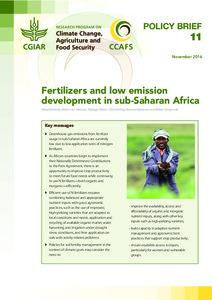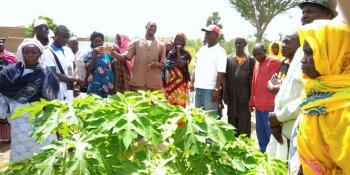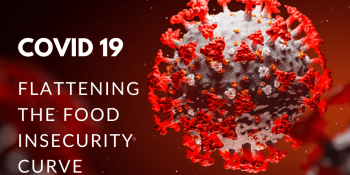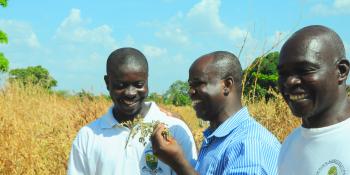Study outlines nutrient management policy considerations relevant for African countries
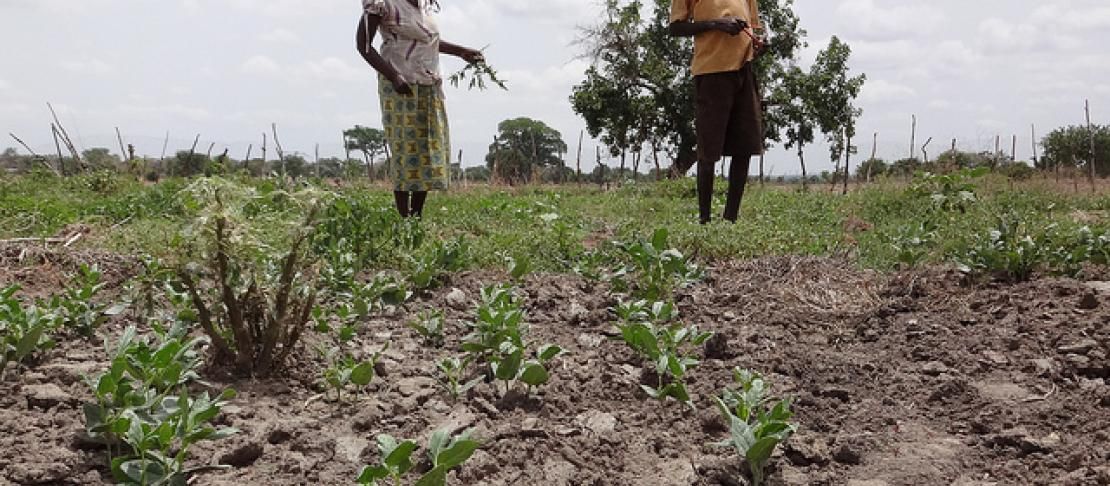
Analysis shows sound nutrient management that increases crop productivity and maintains food security is compatible with low emission development in Africa.
Experts estimate that Africa must triple food production by 2050 to maintain the present level of food self-sufficiency, given the growing population and expected dietary changes. Is this feasible?
In a CCAFS policy brief launched this month, researchers argue that policies supporting informed and inclusive agriculture and soil fertility management strategies would support farmers to increase food security and adapt to climate change while limiting associated greenhouse gas emissions, and thus allow countries to meet their national Paris Climate Agreement goals.
Closing the yield gap
Meeting production targets would require either converting 80 million hectares of land to agriculture or closing the yield gap, which is the difference between potential and actual yield. Large-scale conversion of lands would destroy forest-based livelihoods, decrease biodiversity, and significantly increase net greenhouse gas emissions. Also associated with land conversion is the fact that smallholder farmers would not increase incomes or food security by continuing low yield practices. And closing the yield gap?
"Closing the yield gap is the most sustainable – and profitable – way for Africa to feed itself in the future,” said Robert Zougmoré, CCAFS West Africa Regional Program Leader and an author of the policy brief. “Because application rates of nitrogen fertilizers in Africa are so low, we have an opportunity to vastly increase yields by vastly scaling up inorganic and organic fertilizer use in tandem with other soil management practices. If we can maximize nutrient use efficiency, we can also maximize benefits to the farmer, while minimizing greenhouse gas emissions.”
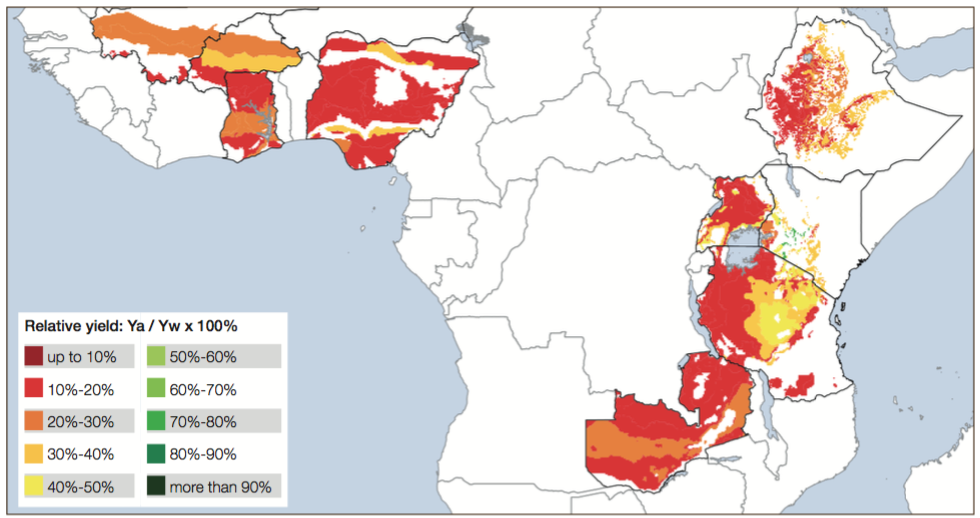
Figure 2 from the policy brief: Relative yield gap of maize, measured by actual maize yields (Ya) as a percentage of their water-limited yield potential (Yw), for countries in West and East Africa. Data from www.yieldgap.org.
Improving nutrient use efficiency requires an integrated approach, for example integrated soil fertility management, which includes organic and inorganic inputs that have complementary functions. While organic inputs produced on-farm such as compost and manure may have lower emissions from production and transportation than inorganic fertilizers, the availability of both quality and quantity organic fertilizers varies widely.
Effective nutrient management strategies will make optimal use of locally available organic material as well as judicious and balanced use of inorganic fertilizer,” said lead author Meryl Richards, a research scientist at the University of Vermont's Gund Institute for Ecological Economics and a science officer for CCAFS Low emission agriculture research.
CCAFS is now partnering with Wageningen University and Research Center and the International Maize and Wheat Improvement Center (CIMMYT) to analyze location-specific conditions into account and recommend the best use of available technologies to close the nutrient yield gap in Africa. Researchers will include trade-off analysis of environmental and farm economic objectives at the farm level. While the project focuses on a number of locations, the approach will be generic and applicable to other countries and usable by the private sector.
Though currently still rather expensive and perhaps cost-prohibitive, Africa may also be able to take advantage of advanced fertilizer technologies such as slow- and controlled-release fertilizers, fertigation, and biofertilizers in future years.
Policy options for more food, less emissions
As African countries implement their Nationally Determined Contributions to the Paris Agreement, they have opportunities to significantly improve crop productivity to meet future food needs and improve farmers’ livelihoods while minimizing the impact on the environment,” Richards said. “This policy brief draws attention to the importance of soil management to achieve these goals and suggests research-based policy options.”
With the common goal of high-yielding agricultural systems accompanied by minimal greenhouse gas emissions, the authors describe five components of successful nutrient management policies.
- Build capacity in adaptive nutrient management. Extension staff and farmers should receive training in analysis of soil fertility (through soil testing or leaf colour charts, for example) and carrying out good soil fertility practices, including local practices, integrated soil fertility management, the “4Rs” (right source of nutrients, right rate, right time, right place), and appropriate fertilizer handling.
- Support balanced nutrient inputs. Balanced nutrient inputs can be achieved through organic inputs, inorganic inputs, and liming. In addition to nitrogen, phosphorus, and potassium (NPK) fertilizers, consideration should also be given to sulfur and other potential micronutrient deficiencies.
- Strengthened and equitable access to nutrient inputs. Farmers require increased access to to inorganic fertilizers and improved seeds as well as support to increase organic inputs from numerous sources, including nitrogen-fixing trees and manure compost.
- Emphasize institutional links and social equity. Ensure that women have more opportunities to benefit from training, trade, and use of inputs and technologies to improve yields and nutrient use efficiency.
- Monitor greenhouse gas emission intensities (emissions per unit of production) along with absolute emissions. With effective soil fertility management, increased production can be accompanied by decreased emissions per unit of production.
The need for investing in sustainable, resilient soil management practices was highlighted at an Adaptation of African Agriculture (AAA) conference on the sidelines of COP22 co-organized by CCAFS and the Government of Morocco.
95% of food we eat grows on soil,” co-author Professor Tekalign Mamo, laureate of the 2016 IFA Norman Borlaug Award and distinguished soil scientist and former Ethiopian State Minister of Agriculture, said at the conference. “It is the responsibility of scientists and professionals to inform policy makers about what must be done. 2015-2024 is the decade of soils. It’s time to act to preserve this non-renewable, finite resource.”
Read more:
Richards M, van Ittersum M, Mamo T, Stirling C, Vanlauwe B, Zougmoré R. 2016. Fertilizers and low emission development in sub-Saharan Africa.CCAFS Policy Brief no. 11. Copenhagen, Denmark: CGIAR Research Program on Climate Change, Agriculture and Food Security (CCAFS).
Rosenstock TS, Rufino MC, Butterbach-Bahl K, Wollenberg L, Richards M. (Eds.) 2016. Methods for Measuring Greenhouse Gas Balances and Evaluating Mitigation Options in Smallholder Agriculture. Springer. Including a chapter on Quantifying Greenhouse Gas Emissions from Managed and Natural Soils.
Bellarby J, Stirling C, Vetter SH, Kassie M, Kanampiu F, Sonder K, Smith P, Hillier J. 2014. Identifying secure and low carbon food production practices: A case study in Kenya and Ethiopia. Agriculture, Ecosystems & Environment 197:137–146.
Campbell BM, Thornton P, Zougmoré R, van Asten P and Lipper L. 2014. Sustainable intensification: What is its role in climate smart agriculture? Current Opinion in Environmental Sustainability 8:39-43.
Farnworth CR, Baudron F, Andersson JA, Misiko M, Badstue L, Stirling CM. 2015. Gender and conservation agriculture in East and Southern Africa: towards a research agenda. International Journal of Agricultural Sustainability 14:142– 165.
Roobroeck D, van Asten P, Jama B, Harawa R, Vanlauwe B. 2015. Integrated Soil Fertility Management: Contributions of framework and practices to climate-smart agriculture. Climate-Smart Agriculture Practice Brief. Copenhagen, Denmark: CGIAR Research Program on Climate Change, Agriculture and Food Security (CCAFS).

